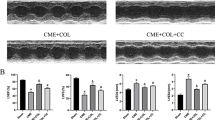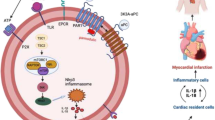Abstract
The objective of this study was to evaluate the effects of specific NF-κB inhibitor pyrrolidine dithiocarbamate (PDTC) on inflammatory response and cardiac function in a rat model of coronary microembolization (CME). CME was developed by injecting a suspension of microthrombotic particles (MTPs) into the left ventricle when obstructing the ascending aorta. MTPs were generated from the rat clots sized by filtration through 38 μm screen. Thirty-two Sprague–Dawley rats served as sham group, 128 CME rats were randomized to untreated (CMEU) and PDTC-treated (CMEp) group. Rats in CMEp were administered intraperitoneally with 50, 100, 200 mg kg−1 day−1 PDTC, respectively, from 1 h before to 7 days after operation. The rats were sacrificed on day 1, 3, 7, 14 post-operationally and each subgroup consisted of eight rats. The general morphological characteristics were observed in sections with HE staining, and the severity of myocardial loss (SML) was determined by percent micro-necrotic area in sections with hematoxylin basic fuchsin picric (HBFP) staining 1 day or by percent micro-fibrotic area in sections with Masson’s trichrome staining 14 days post-operationally. Left ventricular (LV) function was evaluated echocardiographically and hemodynamically. Activity of NF-κB/DNA-binding was analyzed by electrophoresis mobility shift assays (EMSA), and expressions of TNF-α, IL-6, and ICAM-1 genes and proteins were detected by Real-time PCR and western blots, respectively. CME rats exhibited pathological changes evidenced by multi-focal myocardial necrosis, inflammatory cell infiltration with remarkably increased SML and persistent reduction of LV function. Activity of NF-κB/DNA-binding was markedly increased, also TNF-α, IL-6 and ICAM-1 transcripts and their protein expressions were upregulated strongly in the myocardium following CME. PDTC in a dose-dependency significantly suppressed the myocardial inflammatory cytokine transcriptions, decreased SML and improved LV function. Thus, NF-κB is markedly activated in CME hearts, and inhibition of NF-κB by PDTC prevents the subsequent inflammatory activation and improves cardiac function. Patients with or at risk of CME may benefit from acute anti-inflammatory treatment with PDTC.







Similar content being viewed by others
References
Adhikari N, Charles N, Lehmann U, Hall JL (2006) Transcription factor and kinase-mediated signaling in atherosclerosis and vascular injury. Curr Atheroscler Rep 8:252–260
Almawi WY, Melemedjian OK (2002) Negative regulation of nuclear factor-kappaB activation and function by glucocorticoids. J Mol Endocrinol 28:69–78
Alpert JS, Thygesen K (2000) Myocardial infarction redefined a consensus document of Cardiology/American College of Cardiology committee for the redefinition of myocardial infarction. Eur Heart J 21:1502–1513
Arca M, Gaspardone A (2007) Atorvastatin efficacy in the primary and secondary prevention of cardiovascular events. Drugs 67:29–42
Barnes PJ, Liu SF (1995) Regulation of pulmonary vascular tone. Pharmacol Rev 47:87–131
Böse D, von Birgelen C, Zhou XY, Schmermund A, Philipp S, Sack S, Konorza T, Möhlenkamp S, Leineweber K, Kleinbongard P, Wijns W, Heusch G, Erbel R (2008) Impact of atherosclerotic plaque composition on coronary microembolization during percutaneous coronary interventions. Basic Res Cardiol 103:587–597
Bramos D, Ikonomidis I, Tsirikos N, Kottis G, Kostopoulou V, Pamboucas C, Papadopoulou E, Venetsanou K, Giatrakos N, Yang GZ, Nihoyannopoulos P, Toumanidis S (2008) The association of coronary flow changes and inflammatory indices to ischaemia–reperfusion microvascular damage and left ventricular remodelling. Basic Res Cardiol 103:345–355
Collins T, Read MA, Neish AS, Whitley MZ, Thanos D, Maniatis T (1995) Transcriptional regulation of endothelial cell adhesion molecules: NF-kappa B and cytokine-inducible enhancers. FASEB J 9:899–909
Dörge H, Neumann T, Behrends M, Skyschally A, Schulz R, Kasper C, Erbel R, Heusch G (2000) Perfusion–contraction mismatch with coronary microvascular obstruction: role of inflammation. Am J Physiol Heart Circ Physiol 279:H2587–H2592
Dörge H, Schulz R, Belosjorow S, Post H, van de Sand A, Konietzka I, Frede S, Hartung T, Vinten-Johansen J, Youker KA, Entman ML, Erbel R, Heusch G (2002) Coronary microembolization: the role of TNF-alpha in contractile dysfunction. J Mol Cell Cardiol 34:51–62
Erbel R, Heusch Gerd (2002) Feature: coronary microembolization—its role in acute coronary syndromes and interventions. J Invasive Cardiol 14:49C–63C
Erbel R, Heusch G (1999) Spontaneous and iatrogenic microembolization. A new concept for the pathogenesis of coronary artery disease. Herz 24:493–495
Gallagher G, Menzie S, Huang Y, Jackson C, Hunyor SN (2007) Regional cardiac dysfunction is associated with specific alterations in inflammatory cytokines and matrix metalloproteinases after acute myocardial infarction in sheep. Basic Res Cardiol 102:63–72
Gill RM, Jones BD, Corbly AK, Wang J, Braz JC, Sandusky GE, Wang J, Shen W (2006) Cardiac diastolic dysfunction in conscious dogs with heart failure induced by chronic coronary microembolization. Am J Physiol Heart Circ Physiol 291:H3154–H3158
Gwechenberger M, Mendoza LH, Youker KA, Frangogiannis NG, Smith CW, Michael LH, Entman ML (1999) Cardiac myocytes produce interleukin-6 in culture and in viable border zone of reperfused infarctions. Circulation 99:546–551
Herrmann J, Lerman A, Baumgart D, Volbracht L, Schulz R, von Birgelen C, Haude M, Heusch G, Erbel R (2002) Preprocedural statin medication reduces the extent of periprocedural non-q-wave myocardial infarction. Circulation 106:2180–2183
Herrmann J (2005) Peri-procedural myocardial injury: 2005 update. Eur Heart J 26:2493–2519
Heusch G, Schulz R (2003) Heart 89:981–982 (© 2003 by BMJ Publishing Group & British Cardiac Society Pathophysiology of coronary microembolisation)
Heusch G, Schulz R, Haude M, Erbel R (2004) Coronary microembolization. J Mol Cell Cardiol 37:23–31
Huang Y, Hunyor SN, Jiang L, Kawaguchi O, Shirota K, Ikeda Y, Yuasa T, Gallagher G, Zeng B, Zheng X (2004) Remodeling of the chronic severely failing ischemic sheep heart after coronary microembolization: functional, energetic, structural, and cellular responses. Am J Physiol Heart Circ Physiol 286:H2141–H2150
Kawano H, Hayashida T, Ohtani H, Kanda M, Koide Y, Baba T, Toda G, Shimokawa I, Yano K, Okada R (2005) Histopathological findings of the no-reflow phenomenon following coronary intervention for acute coronary syndrome. Int Heart J 46:327–332
Kudo M, Aoyama A, Ichimori S, Fukunaga N (1982) An animal model of cerebral infarction-homologous blood clot emboli in rats. Stroke 13:505–508
Lee KW, Norell MS (2008) Management of ‘no-reflow’ complicating reperfusion therapy. Acute Card Care 10:5–14
Li C, Browder W, Kao RL (1999) Early activation of transcription factor NF-kappa B during ischemia in perfused rat heart. Am J Physiol 276:H543–H552
Liu SF, Ye X, Malik AB (1999) Inhibition of NF-κB activation by pyrrolidine dithiocarbamate prevents in vivo expression of proinflammatory genes. Circulation 100:1330–1337
Liu SF, Ye X, Malik AB (1999) Pyrrolidine dithiocarbamate prevents I-kappaB degradation and reduced microvascular injure induced by lipopolysacchatide in multiple organs. Mol Pharmacol 55:658–667
Liu X, Shen J, Jin Y, Duan M, Xu J (2006) Recombinant human erythropoietin (rhEPO) preconditioning on nuclear factor-kappa B (NF-kB) activation & proinflammatory cytokines induced by myocardial ischaemia–reperfusion. Indian J Med 124:343–354
Liuzzo G, Santamaria M, Biasucci LM, Narducci M, Colafrancesco V, Porto A, Brugaletta S, Pinnelli M, Rizzello V, Maseri A, Crea F (2007) Persistent activation of nuclear factor kappa-B signaling pathway in patients with unstable angina and elevated levels of C-reactive protein evidence for a direct proinflammatory effect of azide and lipopolysaccharide-free C-reactive protein on human monocyte via nuclear factor kappa-B activation. J Am Coll Cardiol 49:195–197
Lu L, Chen SS, Zhang JQ, Ramires FJ, Sun Y (2004) Activation of nuclear factor-kappaB and its proinflammatory mediator cascade in the infarcted rat heart. Biochem Biophys Res Commun 321:879–885
Meyer M, Schreck R, Bacuerle PA (1993) H2O2 and antioxidants have opposite effects on activation of and AP-1 in intact cells: AP-1 as secondary antioxidant-responsive factor. EMBO J 12:2005–2015
Michael E, Ritchie MD (1998) Nuclear factor-κb is selectively and markedly activated in humans with unstable angina pectoris. Circulation 98:1707–1713
Michałek A (2007) Results of ARMYDA-ACS trial show good outcome of 80 mg atorvastatin pretreatment in patients with acute coronary syndromes undergoing early percutaneous coronary intervention. Kardiol Pol 65:851–852
Monroe RG, LaFarge CG, Gamble WJ, Kumar AE, Manasek FJ (1971) Left ventricular performance and coronary flow after coronary embolization with plastic microspheres. J Clin Invest 50:1656–1665
Mood GR, Bavry AA, Roukoz H, Bhatt DL (2007) Meta-analysis of the role of statin therapy in reducing myocardial infarction following elective percutaneous coronary intervention. Am J Cardiol 100:919–923
Nigam A, Kopecky SL (2002) Therapeutic potential of monoclonal antibodies in myocardial reperfusion injury. Am J Cardiovasc Drugs 2:367–376
Ono K, Masuyama T, Yamamoto K, Doi R, Sakata Y, Nishikawa N, Mano T, Kuzuya T, Takeda H, Hori M (2002) Echo doppler assessment of left ventricular function in rats with hypertensive hypertrophy. J Am Soc Echocardiogr 15:109–117
Pasceri V, Patti G, Di Sciascio G (2006) Prevention of myocardial damage during coronary intervention. Cardiovasc Hematol Disord Drug Targets 6:77–83
Patti G, Pasceri V, Colonna G, Miglionico M, Fischetti D, Sardella G, Montinaro A, Di Sciascio G (2007) Atorvastatin pretreatment improves outcomes in patients with acute coronary syndromes undergoing early percutaneous coronary intervention: results of the ARMYDA-ACS randomized trial. J Am Coll Cardiol 49:1272–1278
Roberts R, DeMello V (1976) Deleterious effects of methylprednisolone in patients with myocardial infarction. Circulation 53: I-204–I-206
Sabbah HN, Stein PD, Kono T, Gheorghiade M, Levine TB, Jafri S, Hawkins ET, Goldstein S (1991) A canine model of chronic heart failure produced by multiple sequential coronary microembolizations. Am J Physiol Heart Circ Physiol 29:H1379–H1384
Scherck R, Meier B, Männel DN, Dröge W, Baeuerle PA (1992) Dithiocarbamates as potent inhibitors of nuclear factor κB activation in intact cells. J Exp Med 175:1181–1194
Schulz R, Heusch G (2009) Tumor necrosis factor-α and its receptors 1 and 2 yin and yang in myocardial infarction? Circulation 119:1355–1377
Sciascio GD, Patti G, Pasceri V et al (2009) ARMYDA-RECAPTURE (Atorvastatin for Reduction of Myocardial Damage during Angioplasty) trial-Prospective, multicenter, randomized, double blind trial investigating efficacy of atorvastatin reload in patients on chronic statin therapy undergoing PCI. ACC 2009
Skyschally A, Gres P, van Caster P, van de Sand A, Boengler K, Schulz R, Heusch G (2008) Reduced calcium responsiveness characterizes contractile dysfunction following coronary microembolization. Basic Res Cardiol 103:552–559
Skyschally A, Haude M, Dörge H, Thielmann M, Duschin A, van de Sand A, Konietzka I, Büchert A, Aker S, Massoudy P, Schulz R, Erbel R, Heusch G (2004) Glucocorticoid treatment prevents progressive myocardial dysfunction resulting from experimental coronary microembolization. Circulation 109:2337–2342
Skyschally A, Leineweber K, Gres P, Haude M, Erbel R, Heusch G (2006) Coronary microembolization. Basic Res 101:373–382
Skyschally A, Schulz R, Haude M, Erbel R, Heusch G (2004) Coronary microembolization: perfusion–contraction mismatch secondary to myocardial inflammation. Herz 29:777–781
Timothy S, Blackwell, Christman JW (1997) The role of nuclear factor-κB in cytokin gene regulation. Am J Respir Cell Mol Biol 17: 3–9
Valero SJ, Moreno R, Reves RM, Recalde AS, Galeote G, Calvo L, Villate A, Sendón JL (2008) Pharmacological approach of no-reflow phenomenon related with percutaneous coronary interventions. Cardiovasc Hematol Agents Med Chem 6:125–129
Wilson SH, Best PJ, Edwards WD, Holmes DR Jr, Carlson PJ, Celermajer DS, Lerman A (2002) Nuclear factor-kappa B immunoreactivity is present in human coronary plaque and enhanced in patients with unstable angina pectorsis. Atherosclerosis 160:147–153
Xie HQ, Choi RC, Leung KW, Siow NL, Kong LW, Lau FT, Peng HB, Tsim KW (2007) Regulation of a transcript-encoding the proline-rich membrane anchor (PRiMA) of globular muscle acetylcholinesterase: the suppressive roles of myogenesis and innervating nerves. J Biol Chem 282:11765–11775
Author information
Authors and Affiliations
Corresponding author
Rights and permissions
About this article
Cite this article
Li, S., Zhong, S., Zeng, K. et al. Blockade of NF-κB by pyrrolidine dithiocarbamate attenuates myocardial inflammatory response and ventricular dysfunction following coronary microembolization induced by homologous microthrombi in rats. Basic Res Cardiol 105, 139–150 (2010). https://doi.org/10.1007/s00395-009-0067-6
Received:
Revised:
Accepted:
Published:
Issue Date:
DOI: https://doi.org/10.1007/s00395-009-0067-6




